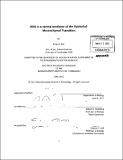ZEB1 is a central mediator of the Epithelial-Mesenchymal Transition
Author(s)
Kah, Kong Jie
DownloadFull printable version (11.33Mb)
Other Contributors
Massachusetts Institute of Technology. Dept. of Biology.
Advisor
Robert A. Weinberg.
Terms of use
Metadata
Show full item recordAbstract
Carcinomas are solid tumors arising from epithelial tissue, and account for the majority of cancer deaths in the United States. In most occurrences of carcinoma, it is the metastases that kill, not the primary tumor. The Epithelial-Mesenchymal Transition (EMT) provides a model by which tightly associated epithelial cancer cells can disseminate to distant sites. Many factors are known to trigger the EMT, but the extent to which the observed phenotypes represent a common process is unknown. There is also little appreciation of the extent to which EMT-inducing factors interact with one another or act on common or redundant pathways. In this study, I sought a common gene expression signature of the EMT by comparing five mesenchymal cell lines independently derived from the same parental epithelial line using different EMT-inducing factors. The resultant EMT core signature strongly suggested a common pathway is involved. Bioinformatics analysis revealed the transcription factor ZEBI to be a possible mediator of this common pathway. ZEB1 was found to be both sufficient to induce EMT and necessary for maintaining the mesenchymal phenotype in the same cells. ZEBI and miR-200 were known to reciprocally regulate each other, but their relative importance to the EMT phenotype had never been directly tested. I found that ZEB1 induced EMT regardless of miR-200c levels, thereby excluding the model in which miR-200c downregulation is a necessary step for the EMT. I also show evidence that EMT induced by the transcription factor Snail works at least in part through ZEB1.
Description
Thesis (Ph. D.)--Massachusetts Institute of Technology, Dept. of Biology, 2012. Vita. Cataloged from PDF version of thesis. Includes bibliographical references.
Date issued
2012Department
Massachusetts Institute of Technology. Department of BiologyPublisher
Massachusetts Institute of Technology
Keywords
Biology.